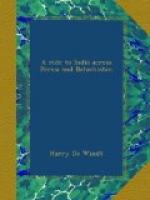With the exception of the Lakh Pass leading over a chain of hills about eighteen miles due west of Beila, the road to Noundra was as flat as a billiard-table. The crossing of the Lakh, however, was not accomplished without much difficulty and some danger; for the narrow pathway, leading over rocky, almost perpendicular, cliffs, three to four hundred feet high, had, in places, almost entirely crumbled away. The summits of these cliffs present a curious appearance—fifty to sixty needle-like spires, hardly a couple of feet thick at the top, which look as if the hand of man and not of nature had placed them in the symmetrical order in which they stand, white and clear-cut against the deep-blue sky, slender and fragile as sugar ornaments, and looking as though a puff of wind would send them toppling over. The ascent was terribly hard work for the camels, and, as the track is totally unprotected by guard-rail of any kind, anything but comfortable for their riders. Towards the summit we met a couple of these beasts laden with tobacco from Kej, in charge of a wild-looking fellow in rags, as black as a coal, who eyed us suspiciously, and answered in sulky monosyllables when asked where he hailed from. His merchandise, consisting of four small bags, seemed hardly worth the carrying, but Kej tobacco fetches high prices in Beila. At this point the pathway had latterly been widened by order of the Djam. Formerly, if two camels travelling in opposite directions met, their respective owners drew lots. The animal belonging to the loser was then sacrificed and pushed over the precipice to clear the way for the other.
In the wet season a foaming torrent dashes through the Valley of Lakh, but this was, at the time of my visit, a dry bed of rock and shingle. Indeed, although we were fairly fortunate as regard wells, and I was never compelled to put the caravan on short allowance, I did not pass a single stream of running water the whole way from Sonmiani to Dhaira, twenty miles south of Gwarjak, though we must in that distance have crossed at least fifteen dry river-beds, varying from twenty to eighty yards in width.




